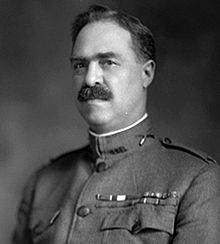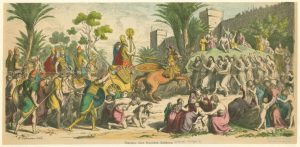General John Henry Parker is best known for his role as the commander of the Gatling Gun detachment during the Spanish-American War. In early 1898, then Lieutenant Parker, a recent graduate of the United States Military Academy, was placed in charge of training soldiers in the use of machine guns. His detachment was a dumping ground for soldiers not fit to serve in other areas, and at that time, the idea of using machine guns in battle was of little value to the US Army. However, Parker believed machine guns could play a vital role in battle.1
In this time period, large artillery had to be transported by draft animals. This was not always a feasible possibility given the terrain, the time frame, and the fact that animals could be killed by enemy fire. Lt. Parker was able to see the purpose of machine guns as a replacement for artillery in battle, especially at ranges closer than 1500 yards.2 He petitioned the US Army for a chance to build a machine gun detachment that could be used for offensive battle tactics, and was granted permission to put a unit together shortly before being sent to Cuba during the Spanish-American War.

Lt. Parker was given four brand new 1895 Gatling guns of .30 caliber. The Gatling gun works by gravity feeding bullets into the top and dropping shells out the bottom, while the shaft was turned by a hand-crank. The gun’s swivel mount and rapid fire allowed the shooter to aim and shoot over long distances of up to 2000 yards, protecting the shooter from enemy fire by artillery. The only disadvantage of the Gatling gun, aside from a lack of training on the weapon, was that it was prone to jamming.3
At the start of the Spanish-American War, Lt. Parker and his Gatling Gun Detachment were assigned to the 5th Army Corps. It would be the first time the US Army would use machine guns as an offensive weapon during battle. On July 1, 1898, the Battle of San Juan Hill began early in the morning. Theodore Roosevelt’s Rough Riders and the Buffalo Soldiers of the 10th Calvary and the 24th Infantry Regiments were attempting to take San Juan Hill and Kettle Hill. The US Army was off to an early loss on that first day of the battle. It was not until the afternoon, when Lt. Parker positioned his Gatling guns and opened fire, that the battle went in favor of the US Army.4 The US artillery used black powder and the Spanish Army used smokeless powder, allowing the Spanish Army to see and fire upon the US artillery. The Gatling guns, however, were smokeless.5
Lt. Parker was ordered to move his guns as close to the battle as he could. He moved them to El Poso, the southern end of the area, where they could attack a blockhouse, the trenches, and the barbed wire entanglements of the Spanish Army. For eight-and-a-half minutes the Gatling guns fired continuously upon the Spanish, causing the soldiers to flee the trenches in an attempt to reach safety. Teddy Roosevelt is known to have said that the sound of the Gatling guns “was most inspiring” to the US soldiers. The Gatling guns were re-positioned, and they fended off the Spanish counterattack.6 Parker’s soldiers and the Gatling guns were with the US soldiers during the entire siege, even down in the trenches.7

Although the US lost three times the number of soldiers as the Spanish, supporting fire from the Gatling guns was crucial to the success of the Battle of San Juan. The artillery were only able to shoot about 270 fragments, while the Gatling guns were able to shoot with precision about 1000 shots.8 For the first time in history, machine guns were used offensively in a battle and were able to successfully disable an opposing army’s artillery. Spanish Army General Jose Toral said in his official report that the Gatling guns and their fire power was a major reason for the Spanish surrender.9
Lt. Parker was awarded the Silver Star for gallantry in action and was eventually promoted to general. He continued his military career by training other armies in Europe in the use of machine guns in warfare. Prior to the Spanish-American War, Parker believed that using machine guns in close battle would allow troops to advance under the protection of the machine guns, harming the enemy and improving the morale of US soldiers. This value of the machine gun had been proven.10
- John H. Parker, History of the Gatling Gun Detachment Fifth Army Corps, at Santiago (Kansas City, MO: Hudson-Kimberly Publishing Co, 1898), 14, 18-25. ↵
- John H. Parker, History of the Gatling Gun Detachment Fifth Army Corps, at Santiago (Kansas City, MO: Hudson-Kimberly Publishing Co, 1898), 62. ↵
- John H. Parker, History of the Gatling Gun Detachment Fifth Army Corps, at Santiago (Kansas City, MO: Hudson-Kimberly Publishing Co, 1898), 18-19, 27-28. ↵
- John H. Parker, History of the Gatling Gun Detachment Fifth Army Corps, at Santiago (Kansas City, MO: Hudson-Kimberly Publishing Co, 1898), 11. ↵
- Encyclopedia Britannica, January 2012, s.v. “Machine Gun.” ↵
- John H. Parker, History of the Gatling Gun Detachment Fifth Army Corps, at Santiago (Kansas City, MO: Hudson-Kimberly Publishing Co, 1898), 72-93. ↵
- John H. Parker, History of the Gatling Gun Detachment Fifth Army Corps, at Santiago (Kansas City, MO: Hudson-Kimberly Publishing Co, 1898), 11-12. ↵
- John H. Parker, History of the Gatling Gun Detachment Fifth Army Corps, at Santiago (Kansas City, MO: Hudson-Kimberly Publishing Co, 1898), 103. ↵
- “Old Glory to Wave over Santiago Today,” Chicago Tribune, (Chicago, IL), Jul. 17, 1898. ↵
- John H. Parker, History of the Gatling Gun Detachment Fifth Army Corps, at Santiago (Kansas City, MO: Hudson-Kimberly Publishing Co, 1898), 12. ↵



56 comments
Griffin Palmer
This article did a great job on explain John Henry Parker’s involvement with the Spanish-American war. His contribution to the Gatling Gun detachment and training soldiers how to use machine guns would greatly help with America’s success against the Spanish and with future wars in American history. The article did especially well at explaining the Gatling Gun detachment and how it was significant within the Spanish American war.
Victoria Castillo
Interesting article Tyler! I have never heard of General John Henry Parker and the Gatling Gun detachment before reading your article, so this is a whole other perspective I am getting into the Spanish-American War. I did appreciate you going into detail on how the Gatling guns worked as well as giving more insight into how much power it had because I did not have a very clear idea if the machine guns they used then were capable of being used in battle. Although, it was a bit surprising to learn that machine guns weren’t used as offensive weaponry until Parker utilized them that way during the Battle of San Juan.
Darrin Xiong
This was a good read. Very informative and easy to understand. Didn’t know who General John Henry Parker was, but now I do. It was interesting to see that machine guns had little to no value considering how much we use machine guns in this day and age. This article does help show how John Henry Parker got his nickname, “Gatling Gun” Parker.
Nnamdi Onwuzurike
Any time I play video games, I always opt to use a machine gun because they are so devastating so it’s interesting to find out that there was a period when they were frowned upon. Lieutenant Parker had seen the Gatling guns’ future, believed in them, and could see them work perfectly in battle. This is a short article that gets straight to the point. Lovie it!
Jacob Anthony Ayala
This was a fantastic article to read. Learning about the Gatling guns was fun. I didn’t know they were powderless. “Gatling gun parker” is such a cool name as well. The mechanics of it was also really interesting. The fact that gravity was the big player in that gun working was awesome. That gun was truly next level being able to shoot 2000 feet is something unheard of at that time.
Hunter Stiles
First off, Congratulations on such a strong piece! I enjoyed reading this essay a lot, especially because I knew nothing about John Henry Parker or his involvement in the Spanish American War before. It was intriguing to observe how he also played a significant role in guiding experienced recruits in the proper handling of machine guns. I was unaware that the Spanish American War saw the introduction of machine guns in the United States and that it was this innovation that contributed to the Americans’ victory. It’s incredible how firearms have evolved through time; they are now much more powerful, portable, and even simpler to get your hands on. I found your article very educational and organized with such good structure! Very pleased with your work! Good Job!
Maria Luevano
Tyler what a great article! I have never heard of John Henry Parker or even knew what a Gatling gun was. I am surprised to learn that the U.S., did not see machine guns as an ideal weapon or at least never even thought to use them until now. This was a great story and learn how John H. Parker got his nickname “Gatling Gun” Parker.
Isabella Lopez
A quick but informative read. I think you did a great job in keeping it short but still making things meaningful. The interesting thing about the gatling gun is that it was powder-less. I did not expect that from such a big and powerful gun. I enjoyed the part where Roosevelt said the sound of the guns going off was “inspiring”.
Vanessa Rodriguez
I love the amount of details this article provided. What surprised me the most is that animals would transport artillery onto the battle field. Many animals were killed during this transportation and it was obviously not the best idea. I was also intrigued finding out machine guns were not found to be essential at the time. Very interesting article, I loved it.
Danielle Rangel
This was an intriguing article to read! It was a quick and informative read that allowed me to learn a lot. I liked how the author demonstrates the significance of Gatling Gun Parker and the time and effort it took to master a weapon like that. Overall I think this was an informative article and it is significant to see how the US came up with new technology/weapons in order to deal with war.